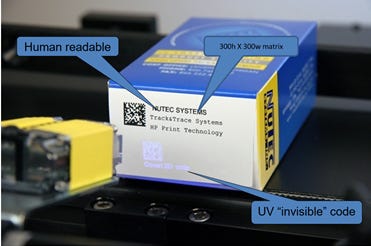Whether required by law or for supply chain communication, package codes need to be present and readable by humans or electronic “eyes.” How can you pick the right technology for the right application?
April 29, 2022

Virtually every product sold requires some kind of code on the package. Lot, date, time, serial number. Your product likely has a variable code. Selecting the proper coder to apply it is critical, for both primary packs and shipping cases. Here are some of the questions you need to ask to make sure you correctly match the coding technology to the task.
1. What is the purpose of the code?
The purpose of the code will determine how frequently it needs to be changed, and how much labor that requires.
A batch code and Sell By date only change every day or two. Simple, relatively inexpensive hot stamp, debossing, and rubber stamp coders (see photo above) changed manually may be the cost-effective solution.
A serial number or time stamp will change frequently. A laser, inkjet, or thermal transfer coder will be the better choice here. These can program the time stamp to automatically change every minute or the serial number to change in some complex pattern.
2. Who is the code for?
Corrugated cases and shippers need a large format code that can be read from a distance. If it needs a bar code, this generally means a “Drop On Demand” (DOD) inkjet. If there is no bar code, a simpler roller coder using rubber type and an ink pad may suffice.
Usually, the code is for the end user. Sometimes a hidden code is needed. Inkjets can print “invisible” UV ink over existing graphics. Proprietary inks can be used for counterfeit control. Another option is to laser print an ultrasmall (<100 microns) code.

Most packaging operations use automated inspection systems to verify the presence and quality of the code before the product ships out. But automated inspection requires consistently legible codes to avoid false rejects. Debossing, while legible to the eye, is difficult to “see” with a camera.
Debossing is similar to hot stamping but presses the type into the substrate with no ink. This allows it to code over existing graphics. A drawback is that it provides little to no contrast and is hard to inspect using automated systems.

Inkjets come in large- and small-character dot matrix formats. Resolution is usually satisfactory but not always as "pretty" as the customer might like. Thermal inkjets, using desktop printer technology, provide high-resolution text and graphics.

3. What is the substrate to be printed?
There is no universal coding solution. All applications are dependent on the substrate and package graphics. Is the substrate porous: Will it absorb the code? Or is the substrate non-porous: Will the print even adhere to the surface?
Lasers focus an intense light beam on the substrate. This ablates (removes) the top ink layer on a printed substrate. A contrasting color block is required for this to be effective. For example, a laser can ablate the red top layer of a carton, creating a white, readable code.
Polyethylene terephthalate (PET), polyvinyl chloride (PVC) and some other “hard” plastics work well with lasers. Polyethylene and others generally do not because they are transparent to the laser beam. Some glass containers will micro-etch. The top coating layer on some metal cans and caps can be ablated to create a contrasted readable code.
Hot stamp coders press metal type against a ribbon to transfer ink to the substrate. They work. They work well on labels, cartons, and films. They do not work well on compressible substrates like corrugated because there is too much give in the surface and the ink will not transfer from ribbon to surface.
Most inkjets will print on most surfaces provided the proper ink is chosen.
4. How are the packages handled on the packaging line?
Inconsistent coding is usually a product handling issue. Most coders are precise, putting the code in the same place every time. Proper coding depends on the package being in the right position on the packaging line.
Inkjets and lasers normally code with the substrate in motion. Variations in speed and position will cause inconsistent codes.
If you don’t ask the right questions, you don’t get the right answers. There is no universal coding solution, so take the time to make sure you get the right one for your product.
About the Author(s)
You May Also Like


